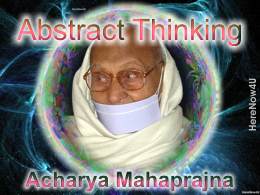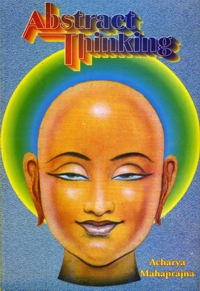
One important accomplishment of meditation is - movement in the direction of truth, the practice of living the truth. Not to make an attempt to falsify the truth is an achievement of meditation. If, even after passing through the process of meditation, we have not been able to develop a realistic outlook, it means that our meditation has not yet matured. Meditation should lead to a spiritual consummation; spirituality must flower.
The consummation of meditation is living a truthful life. When a man stops living a truthful life, many practical problems arise.
The sadhak accepting the great gift of preksha meditation makes a resolve: “I vow to speak the truth" The whole purpose of undertaking meditation is - discovery of truth. The man who does not meditate, cannot progress in the direction of truth. All around us lie many subtle truths, beyond the reach of a gross vision. Nor can a gross mind apprehend these truths. These truths cannot form the subject of a gross consciousness. You need a subtle vision to know and see them, a subtle mind, and a subtle consciousness. Without meditation, the vision does not grow to be subtle, nor can the mind be refined. Nor is it possible to develop a subtle consciousness without meditation. Consciousness is vitiated by attachment and aversion and it is all covered with dirt. Until these are removed, consciousness will continue to be gross. Therefore, a sadhak who practises meditation is engaged first of ail in the discovery of truth and he starts this search of truth on his own. He does not seek truth outside, but inside himself.
The first point of departure for our journey of knowing and seeing, our pilgrimage of the true nature of the soul, is - perception of breathing, the second is - perception of the body.
Perception of body: It seems rather strange that the body in which we have our existence, which is our most intimate friend - what is there in it for us to see? Why should we perceive it? These questions arise as long as we do not start perceiving. The moment perception begins, these questions are resolved. There is a lot to see in the body, so much that our knowledge of it is never complete, however much we may look. Every day one has new experiences, then does one begin to realize that there is so much to perceive that one's perception never ends. In order to make a diagnosis, A physician too, looks inside the body. The greater the proficiency and subtlety with which a therapist looks within the body, the better are the chances of his making the right diagnosis. The physician sets his fingers on the pulse. He catches its beat. With sophisticated instruments he comes to know of the movements inside the body and he tries to grasp the subtle vibrations within. On the basis of the inner pulsations, he goes to the root of the disease and makes his diagnosis. He perceives the whole of the body and comes to know what is happening inside. Mere conjecture cannot be the basis of his diagnosis. Only by looking deep within, is he able to catch hold of the subtlest causes. Going into the depths is important, whether he does so through certain appliances or otherwise, is a different matter. Without going into the depths, one cannot find what one seeks. It is possible to go into the depths through meditation as well as through the appliances. Meditation is observation, the process of seeing.
The dimensions of our search for truth go on increasing. Chiefly, there are four dimensions:
- breathing
- body
- mind, consciousness, intellect
- pure consciousness, the soul.
All these are the dimensions of the search for truth.
Gautam, the senior disciple of Lord Mahavira once asked: "O Illustrious One: What is truth?"
'Truth cannot be told."
'Then how are we to know it?"
"You must discover the truth for yourself."
"How do we seek it?"
"Stop all action. Empty the mind of all thought. Keep silent. Keep the body still."
"O Gentle one: How shall we then carry on the business of living?"
"Be temperate in action: Speak only when you must, and to the point. Walk only when necessary, and with sobriety. Eat rf you have to, in moderation. Exercise restraint in all you do."
"O Illustrious One: If the path leading^ the discovery of truth can be told, why cannot the truth itself be told?"
There are partial truths. A partial truth can be told. My exposition of truth is conditional. The whole truth cannot be told. That is why I say that truth cannot be told: a partial truth can be told. That is why I say truth can be told. Truth cannot be told and it can be told. A relative understanding of both these facts is right knowledge."
 Acharya Mahaprajna
Acharya Mahaprajna

